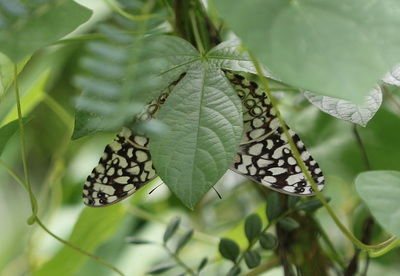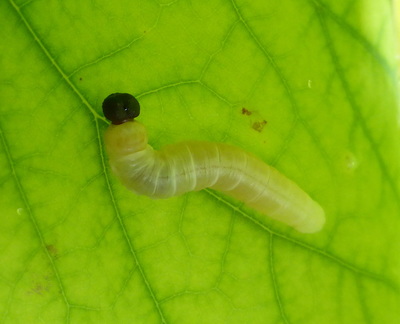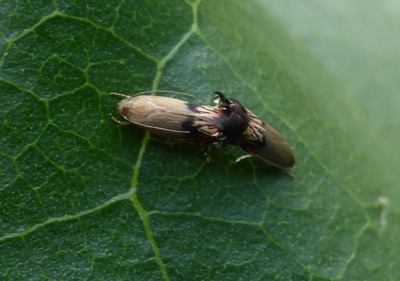By the forest we found two so far unidentified species of micro-moths. The pair in cop were tiny - each about 3mm long - and flew so I couldn't get a better picture unfortunately. On the walk back across the horse fields that were lots of larvae of Tropical Buckeye Junonia zonalis.
|
After breakfast we took a pony trap ride to the track running alongside the Parque Nacional Bahia de Naranjo. Once again two or three male Cuban Leafwing Anaea cubana were holding territory usually sitting quite high on foliage overhanging the track so impossible to get any decent pictures. We also saw both Poey's Swallowtail Heraclides caiguanabus and Oviedo's Swallowtail Heraclides oviedo and glimpsed what was probably a Two-spotted Prepona Archaeoprepona demophoon but I only saw it for a second and it was gone over the tops of the trees. There were lots of Gray Cracker Hamadryas februa about some of which were clearly females looking for somewhere to oviposit so we spent some time watching them and eventually managed to catch a female laying on its foodplant Dalechampia scandens and then found the egg. The three-lobed leaf is quite distinctive and although its not obvious it is a member of the Euphorbiaceae. The leaves or at least the sap of such plants can be a great irritant to the skin but luckily I didn't suffer any ill effects. We saw several small larvae of Gold-spotted Aguna Aguna asander on the Bauhinia bush but didn't see any more adults but here is a picture of one that emerged the following week from a pupa. Like other Pyrginae the small larvae form a shelter on the edge of a leaf by cutting the edges and forming a flap that they fold over with silk. There were ten species of Pieridae flying including several female Cloudless Sulphur Phoebis sennae ovipositing and a smart Three-spotted Skipper Cymaenes tripunctus was the first of the trip. There is little wooded dell on the walk back to our hotel which turned up trumps today with eight species of warbler - Parula, Prairie, Yellow-throated, Ovenbird, Black & White, American Redstart, Black-throated Blue and Worm-eating. The latter is certainly the rarest in the area - Carlos told us that he has only ever seen two. By the forest we found two so far unidentified species of micro-moths. The pair in cop were tiny - each about 3mm long - and flew so I couldn't get a better picture unfortunately. On the walk back across the horse fields that were lots of larvae of Tropical Buckeye Junonia zonalis.
0 Comments
Leave a Reply. |
Welcome to our Blog
Here we will post interesting news about what we and others have seen in Cuba. Archives
July 2024
Categories |














 RSS Feed
RSS Feed